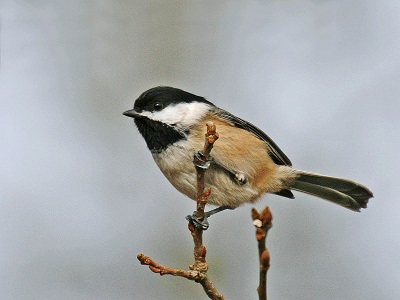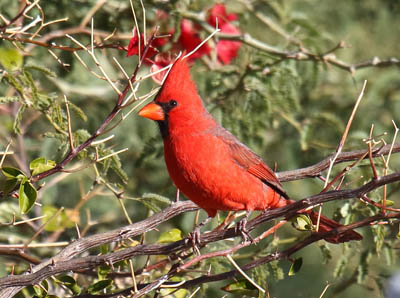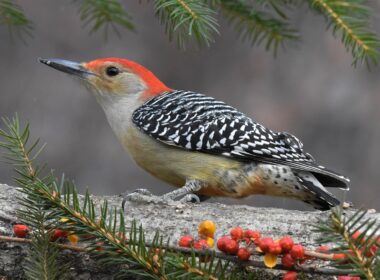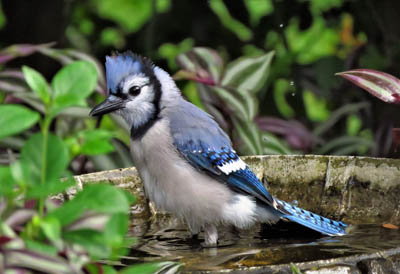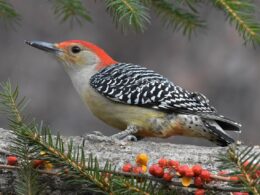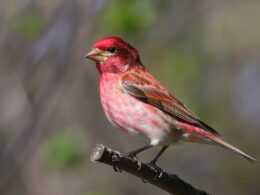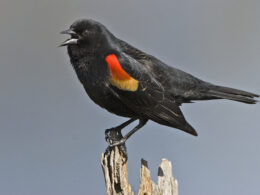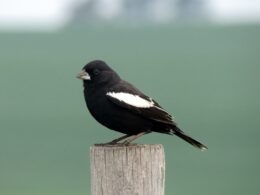Last Updated on January 12, 2024 by Greg Gillson
Did you see a brightly-colored red bird, orange bird, or yellow bird in Ohio and wonder what is was?
This page is for you!
This article shows you photos and identification of some of the most common birds in Ohio based on color.
The list of birds found in Ohio includes over 440 species. So, I can’t show you all of them. I’m going to assume that you saw a common bird of this color, but you certainly could have seen something less common, or even rare!
Shape (including the shape of the bill) and size are often more helpful in starting to identify a bird than the color. In fact, most birds in North American can be easily identified with a black-and-white photo!
Many birds are multi-colored, so that it may be hard to pick out a dominant color. Males and females may be colored quite differently. And some color patterns are similar among otherwise dissimilar species.
Nevertheless, I’m going to try to pick out some of the birds that you are most likely to see in backyards or towns. And I’ll show a few others that I get asked about a lot.
The birds with a noticeable amount of red on them in Ohio covered in this article are:
- Northern Cardinal
- American Robin
- House Finch
- Ruby-throated Hummingbird
- Rose-breasted Grosbeak
- Red-headed Woodpecker
- Scarlet Tanager
- Ruddy Duck
The birds with a noticeable amount of orange on them in Ohio covered in this article are:
- Barn Swallow
- Eastern Towhee
- Baltimore Oriole
- Wood Thrush
- American Redstart
- Brown Thrasher
- Red-shouldered Hawk
- American Kestrel
- Red-breasted Nuthatch
- Orchard Oriole
The birds with a noticeable amount of yellow on them, including lots of yellow and black birds, in Ohio covered in this article are:
- American Goldfinch
- Northern Flicker
- Yellow Warbler
- Common Yellowthroat
- Yellow-rumped Warbler
- Cedar Waxwing
- Great Crested Flycatcher
- Eastern Meadowlark
- Palm Warbler
- Black-throated Green Warbler
- Magnolia Warbler
- Northern Parula
- Nashville Warbler
- Yellow-throated Vireo
- Hooded Warbler
- Yellow-breasted Chat
Red birds of Ohio
Birds get the red, orange, and yellow in their feathers from carotenoids in the fruit, seeds, and plants they eat (source).
These carotenoid colors combine with melanin to form an infinite range of red feathers–pink, rusty, scarlet, violet, red-orange.
The following are red birds that you are most likely to see in Ohio.
Northern Cardinal
These are one of the most common backyard birds in the eastern United States. Their bright red color and unique head profile makes them instantly identifiable to most people–whether they are bird watchers or not!
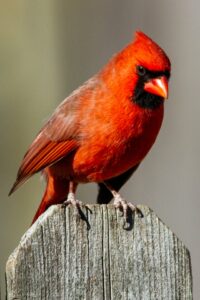
Males of these large seed eaters are bright red with a black face and red crest.
Females replace most of the red with brown, The bill is large and orange.
These birds are found in woodlands, stream edges, residential areas.
Northern Cardinals are year-round residents throughout Ohio.
American Robin
These are familiar lawn birds with red breasts.
 |
| American Robin. Greg Gillson. |
Male American Robins are brownish-gray above with a brick red breast. Females are paler orange below and paler gray above.
They are widespread in open country with scattered deciduous trees, residential areas.
American Robins are year-round residents throughout Ohio.
House Finch
When people ask about a bird with a red head at their feeder, it is usually this bird.
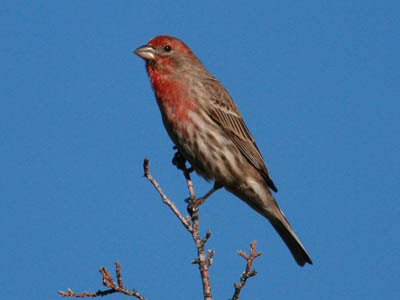 |
| Male House Finch. Greg Gillson. |
Males of this dusty brown striped finch have red limited to the head (specifically the forehead and eyebrow), breast (chest), and rump. The red coloration tends toward orangish, and may rarely be yellowish.
Females are streaked, similar to the males but without red. They lack any strong pattern on the face and head.
Note the small round head and curved upper ridge on the bill.
Some people call these red-headed sparrows. Sparrows and finches are similar, but in general, male finches are brighter than the females and tend to hang out more in trees. Sparrow genders are usually quite similar in coloration and tend to feed mostly on the ground.
These birds are common in residential areas, especially at bird feeders. In the West more widespread in arid regions near water.
House Finches are year-round residents throughout Ohio.
Ruby-throated Hummingbird
These red-throated birds are the only hummingbird nesting in the eastern United States.
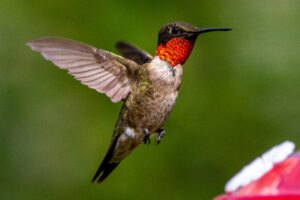
Males are dark green above and on the belly. They have a white upper chest. The throat is ruby-red.
Females are green above, white below, including white throat.
These birds are found in woodland edges, residential yards. Readily come to hummingbird feeders.
Ruby-throated Hummingbirds are summer residents throughout Ohio.
Rose-breasted Grosbeak
These birds with the red breast and huge pink bill sing beautiful robin-like songs from the tops of trees.
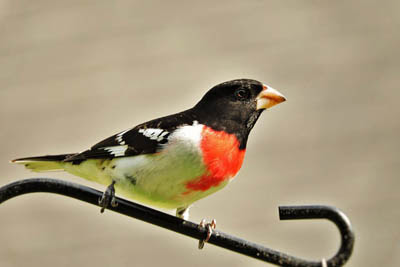 |
| Male Rose-breasted Grosbeak. Susan Killian. Pixabay. |
Males have black hood and upper parts. White under parts. Large white wing patches. Huge pink bill. Inverted bright red triangle on the breast.
Females are brown above, face with broad stripes, white throat. The under parts are buff with many thin brown streaks. Pale bill.
These birds inhabit deciduous and mixed forests. Shade trees in town. Come to feeders.
Rose-breasted Grosbeaks are summer residents throughout most of Ohio, they are spring and fall migrants only in southern Ohio.
Red-headed Woodpecker
These well-known woodpeckers with red heads have a fitting name.
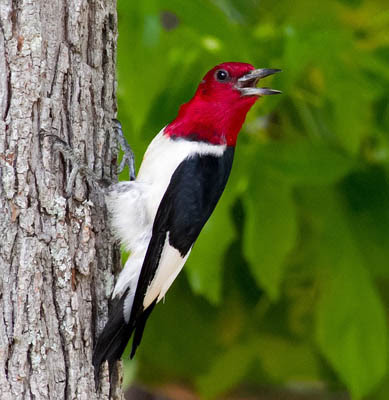 |
| Red-headed Woodpecker. Public domain. |
These birds have the entire head bright deep red. Back and tail black. Underparts white, as are inner secondaries and rump.
They are found in a variety of wooded habitats. They prefer to have oak and beech trees available. Sometimes come to feeders in winter.
Red-headed Woodpeckers are year-round residents throughout Ohio.
Scarlet Tanager
A brilliant red and black bird!
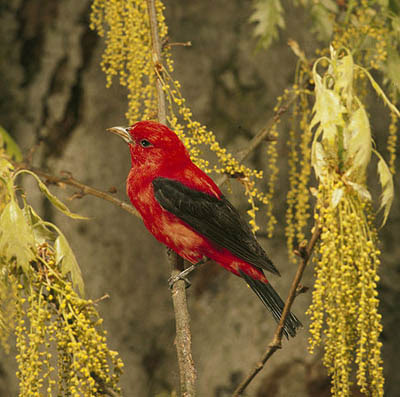 |
| Male Scarlet Tanager. USF&WS. Public Domain. |
Males are unmistakable with brilliant red with black wings and tail.
Females are olive-green above, darker wings and tail, yellower under parts. Pale bill.
These birds live in deciduous woods.
Scarlet Tanagers are summer residents throughout Ohio.
Ruddy Duck
These small ducks are dark rusty-orange in spring.
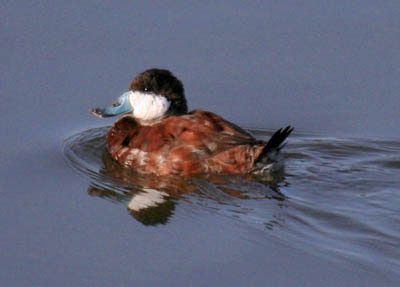 |
| Ruddy Duck. Greg Gillson. |
Males in breeding plumage (late winter and spring) are rusty, with a white face, and a blue bill. The long tail is often held sticking up. In winter they are brown, with white face, and dark bill.
Females all year are like winter males. Brown body, dark cap, dark line through eye of pale face. Dark bill.
These birds prefer weedy ponds to breed, but in winter may be found in deeper ponds in city parks.
Ruddy Ducks are winter visitors throughout Ohio.
Orange birds of Ohio
True orange-colored birds are not that common. Many birds that I have here are paler rusty.
The common pattern is an orange body and black or brown wings and tail. Another common pattern is for the orange to be restricted to the under parts.
The following are orange birds that you are most likely to see in Ohio.
Barn Swallow
These orange-bellied birds are a familiar sight across North America in summer.
 |
| Barn Swallow. Greg Gillson. |
These birds are purple-blue above with orange under parts and long forked tails. The color of the underparts in winter or on females are often cinnamon or buff-colored, but breeding males can be brighter orange-red.
These birds swoop low over fields and wetlands at lower elevations. They may build their mud nests in rafters on porches, garages, or other out-buildings.
Barn Swallows are summer residents throughout Ohio.
Eastern Towhee
These birds with rusty-orange sides like to hide in dense bushes.
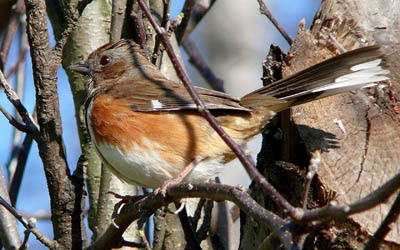 |
| Female Eastern Towhee. Skeeze. Pixabay. |
Males are black above with white wing patch, white tail corners. The sides are rusty. The belly white. Eyes variable: brown, red, orange, white, tending toward whiter southward.
Females are similar, but upper parts brown.
These birds are found in forest understory, dense brush, backyard hedges. Come to feeders.
Eastern Towhees are summer residents throughout most of Ohio, year-round residents in southern Ohio.
Baltimore Oriole
These bright orange and black birds are fairly common breeders in wooded areas in the East.
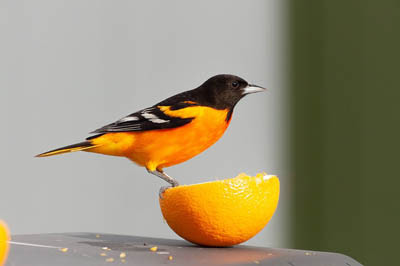 |
| Baltimore Oriole. Michael McGough. Pixabay. |
Males are have a black hood and back. Wings black with white patches. Tail black with orange sides to the base. Bright orange under parts.
Females are similar to males, but more olive above, less black. Immature birds for their first year or more are olive above orangish-yellow on the breast, fading to yellow on the belly. Two white wing bars.
These birds are common in deciduous woods, shade trees.
Baltimore Orioles are summer residents throughout Ohio.
Wood Thrush
These spotted birds with the orange-brown upper parts tend to hide in understory trees and on the forest floor.
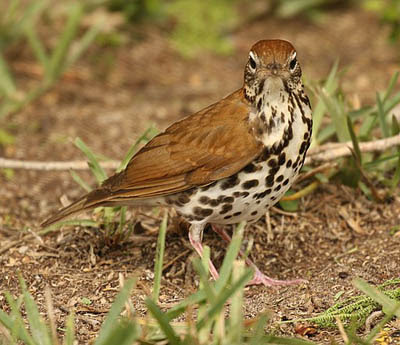 |
| Wood Thrush. Tony Castro. CC BY-SA 4.0 |
These birds are reddish brown on the upper parts, especially rusty orange on the crown and upper back. White eye ring. Large heavy black spots on the under parts.
They live in deciduous and mixed woods. Spend much time on the ground, shuffling through the leaf litter.
Wood Thrushes are summer residents throughout Ohio.
American Redstart
In flight these small warblers flash orange or yellow in the wing and based of the tail.
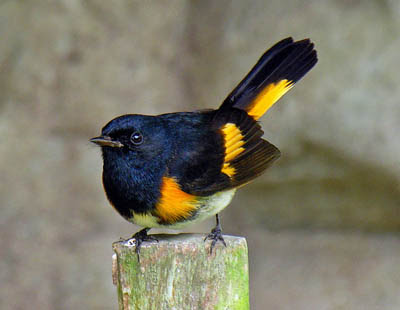 |
| American Redstart. Dennis Jarvis. Flikr. CC BY-SA 2.0 |
Males are black above, white on the belly. They have bright orange patches on side of breast, wings, and base of the tail.
Females are grayer, especially on the head. The orange of males is replaced by yellow on the females.
These birds are found in regenerating woods after a clear cut, and willow tangles along streams.
American Redstarts are summer residents throughout Ohio.
Brown Thrasher
These are rather large rusty-orange songbirds.
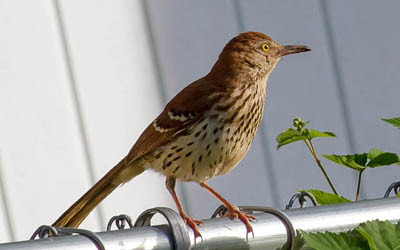 |
| Brown Thrasher. Linda Jones CC0. |
The upper parts of these birds is colored rusty-brown to orange. They show two white wing bars. Under parts are buff with heavy reddish-brown streaking.
These birds live in woodland edges and mature backyard landscaping.
Brown Thrashers are summer residents throughout Ohio.
Red-shouldered Hawk
Okay, the shoulders are reddish. But the rusty-orange breast and wing linings are barred red too.
 |
| Red-shouldered Hawk. Greg Gillson. |
The upper parts are barred black and white. The tail is banded black and white. In adults the breast is barred orange.
Immature birds are streaked with brown on the breast.
These birds like woodland edges, residential edges, riparian groves.
Red-shouldered Hawks are year-round residents throughout Ohio.
American Kestrel
These are the familiar small rusty-orange falcons sitting on power lines on the edge of the highway, or hunting and hovering over the median strip.
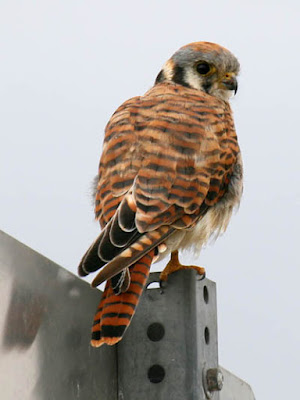 |
| Female American Kestrel. Greg Gillson. |
Females are rusty orange barred with black on their back wings and tail. The under parts are buff with black spots. The head shows two facial stripes.
Males have blue-gray backs and rufous tail is unmarked except for black tail band.
These birds are found in open country, farms, pastures with perches.
American Kestrels are year-round residents throughout Ohio.
Red-breasted Nuthatch
These active little red-breasted birds crawls all around on the trunk and big branches of conifers. They search crevices in the bark for insect food.
 |
| Red-breasted Nuthatch. Greg Gillson. |
These tiny birds have blue-gray backs and a black line through a white face. Some males can have quite bright rusty red under parts. Some females can have quite pale buff-colored under parts. Most birds show an orange-cinnamon breast color.
Found nearly exclusively in conifers. Readily come to feeders.
Red-breasted Nuthatches are winter residents throughout Ohio.
Orchard Oriole
Males of these orioles are darker rustier-orange than most other orioles in the United States.
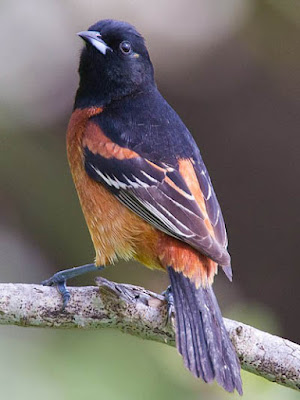 |
| Orchard Oriole. Dan Pancamo. Flikr. CC BY-SA 2.0 |
Males have a black hood and back, black wings and tail. The under parts are rusty-orange or even chestnut-brown.
Females are greenish above, lemon yellow below. They have 2 thin white wing bars. The bill is thinner than many other orioles.
They are found in orchards and residential shade trees.
Orchard Orioles are summer residents throughout Ohio.
Yellow birds of Ohio
Yellow is a common bird color! Often it is mixed with black and white plumage in birds.
Many birds with darker upper parts have yellow breast or belly.
The following are yellow birds you are most likely to see in Ohio.
American Goldfinch
These small little birds are bright yellow and black.
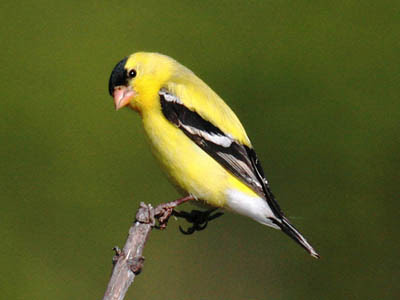 |
| American Goldfinch. Greg Gillson. |
Males are bright lemon yellow with black and white wings and tail, black cap. White under tail coverts. Pink bill.
Females are duller yellow below and brownish above. Lack black cap.
Winter birds are pale brown or gray, a touch of yellow on the throat of males.
These are birds of open country, fields with saplings, clear cuts, residential areas. They avoid dense forests, mountains, deserts. They visit feeders.
American Goldfinches are year-round residents throughout Ohio.
Northern Flicker
These woodpeckers spend much time eating ants on the ground.
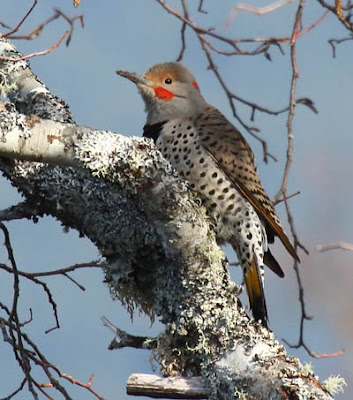 |
| Northern Flicker. Greg Gillson. |
These birds are larger than robins with brown and black barred upper parts. The underparts are pink with round black spots. There is a black crescent across the chest. When they fly away from you they reveal a large white rump.
Western birds have salmon-red under wings and under tail. Those in the East are colored yellow. The male face differs between the two populations–black whisker on the eastern birds, red whisker on western birds. Intergrades from overlap on Great Plains common. These may show male facial characteristics of both populations, or yellow-orange flight feathers.
These birds live in open woods with bare ground for foraging, residential yards.
Northern Flickers are year-round residents throughout Ohio.
Yellow Warbler
The golden yellow sun packed all into one little bird! Appears to be an all-yellow bird.
 |
| Yellow Warbler. Greg Gillson. |
Some populations are bright yellow, some tend toward greenish on upper parts, some more golden. Yellow internal tail corners in flight.
Males with red breast streaking, again, variable by population.
Females somewhat to much paler yellow, some greenish, some whitish. Lack red streaks.
These birds are found in willow thickets on the edge of wetlands and ditches, stream sides in arid regions.
Yellow Warblers are summer residents throughout Ohio.
Common Yellowthroat
These buttery yellow birds are abundant in the marsh vegetation.
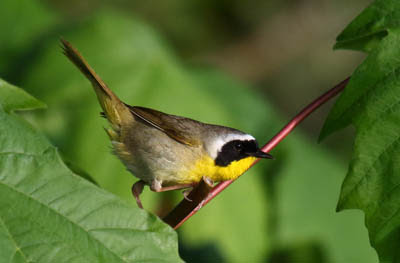 |
| Male Common Yellowthroat. Greg Gillson. |
These skulkers have bright yellow throats and yellow undertail coverts. Males have a black domino mask edged broadly in white, which females lack. Upperparts are dull olive-green.
Immature males in fall show a shadowed black mask.
Found in damp situations and heavy deciduous brambles following clear cuts.
Common Yellowthroats are summer residents throughout Ohio.
Yellow-rumped Warbler
These are abundant warblers across North America. Affectionately called “butter butts” by many birders, because of their bright yellow rumps that flash in flight.
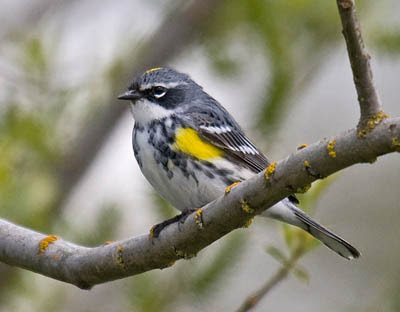 |
| Breeding Yellow-rumped (Myrtle) Warbler. Greg Gillson. |
Western form (Audubon’s) with bright yellow throat and yellow rump. Large white wing patch.
Northern and Eastern form (Myrtle) with white throat, yellow rump, and two white wing bars.
Winter birds are dull gray brown, with bright yellow rump. Throat may be cream colored or white. Often difficult to tell the two forms apart in winter.
 |
| Winter Yellow-rumped Warbler. Greg Gillson. |
Breed in mountain or boreal conifers. Widespread in migration. Winter in low river bottoms, open weedy deciduous areas. Rarely come to feeders in winter.
Yellow-rumped Warblers are winter visitors throughout Ohio, less common in northwestern Ohio.
Cedar Waxwing
These crested birds with yellow band on the end of the tail are often found in flocks. They eat flying insects in summer, fruit and berries the rest of the year.
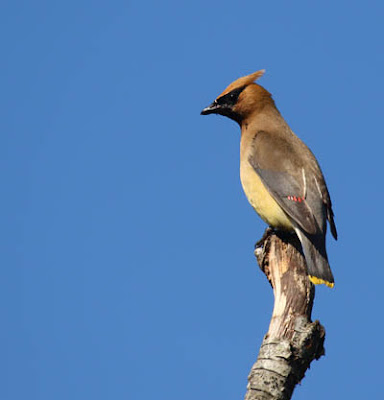 |
| Cedar Waxwing. Greg Gillson. |
These birds are fawn-brown above, with dark gray wings and tail. They have a black mask and wispy crest. The belly is yellow. The wings have waxy red drops on the end of the tertials. The end of the tail has a brilliant yellow tail band.
They are found in open habitats with berries, including juniper woodlands and towns in winter.
Cedar Waxwings are year-round residents throughout Ohio.
Great Crested Flycatcher
These flycatchers have long tails and big heads with big bill and bright yellow belly.
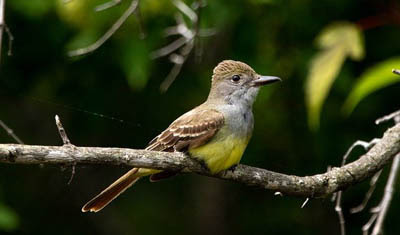 |
| Great Crested Flycatcher. Simard Francois. Pixabay. |
These birds are gray on the face and breast, brownish on rest of upper parts. Bright lemon yellow belly. The under side of the tail and some feathers of the wing are cinnamon colored.
These birds stay in the canopy of open woods.
Great Crested Flycatchers are summer residents throughout Ohio.
Eastern Meadowlark
These pale brown birds with the brilliant yellow breasts are home on the ground in prairies. They sing from perches on isolated trees, power poles, fence posts.
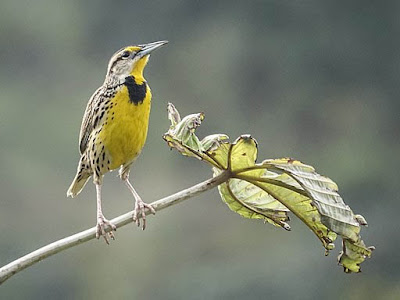 |
|
Eastern Meadowlark
Photo by Mike’s Birds from Riverside, CA, US [CC BY-SA 2.0]
|
The upper parts are streaked black, white, brown, so they blend into the dried grass where they live. The under parts are bright yellow with ablack necklace across the chest. Very similar to Western Meadowlark, best told apart by spring song.
These birds live in prairies and extensive pasture lands.
Eastern Meadowlarks are year-round residents throughout Ohio.
Palm Warbler
This rather drab bird has bright yellow under tail coverts. It tends to spend much time on the ground in disturbed soils. It constantly bobs its tail up and down.
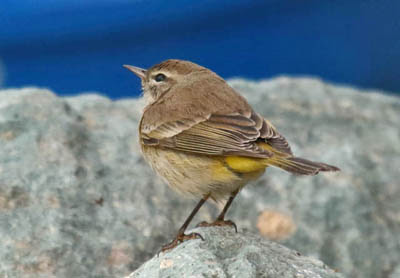 |
| Winter Palm Warbler. Greg Gillson. |
Breeding birds are rather gray with yellow throat, vent and under tail coverts. White eyebrow stripe. Chestnut cap. Eastern birds tend to be more yellowish on the breast.
In winter birds are very pale, but with yellow under tail.
They nest in bogs within boreal forests. They like similar habitat at other times of year: open land with isolated scrubby trees or bushes, including coastal scrub.
Palm Warblers are spring and fall migrants throughout Ohio.
Black-throated Green Warbler
Look for these birds with the yellow faces singing high up in the trees in spring.
 |
| Black-throated Green Warbler. Madeline Allen. Pixabay. |
Males in spring have green back and crown, black throat, circling a bright yellow face.
Females and immatures in fall have a white throat. Greenish ear patch.
Found in many forest types, conifers, mixed forests, and cypress.
Black-throated Green Warblers are primarily spring and fall migrants in Ohio, but also are summer residents in the northeastern corner of Ohio.
Magnolia Warbler
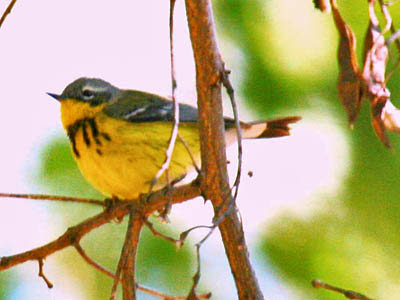 |
| Magnolia Warbler. Greg Gillson. |
Adult males are gray and black above and bright yellow below. Black mask and lower face. Gray crown. Black upper back. Black necklace that breaks into streaks down the breast. White under tail coverts. White under tail base, black terminal tail feathers. Large white wing patch.
Female with two wing bars, black mostly replaced with olive. Immatures for the first year lack black markings.
Live in moist coniferous forests, young stands of spruce and hemlock.
Magnolia Warblers are spring and fall migrants throughout Ohio, it breeds in a few isolated areas of Ohio.
Northern Parula
This is a handsome blue and yellow warbler.
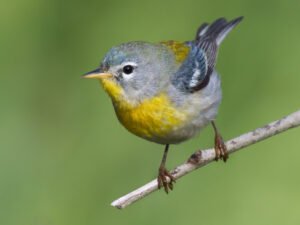
Males are blue on the hood and shoulders. Back green. Yellow throat and breast with a dark red spot mid-chest. Broken white eye ring. Two wide white wing bars.
Females are similar, but paler.
They are found along streams and in swampy forests with willows, maples, birches, hemlocks and other trees.
Northern Parulas are spring and fall migrants throughout Ohio, summer residents in southern and southeastern Ohio.
Nashville Warbler
These birds with the bright yellow underparts do a good job of hiding!
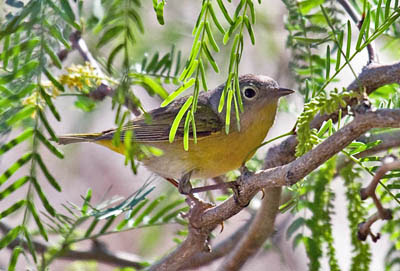 |
| Nashville Warbler. Greg Gillson. |
These birds are gray above. The throat and breast and under tail coverts are bright lemon yellow. The belly is white. They have a complete white eye ring.
Females are just a bit paler than males.
These birds are found in re-growing clear cuts, and understory brush in open woods.
Nashville Warblers are spring and fall migrants throughout Ohio.
Yellow-throated Vireo
Vireos are slow moving small birds that sing throughout the day. These yellow-headed vireos are one of the most colorful of their clan.
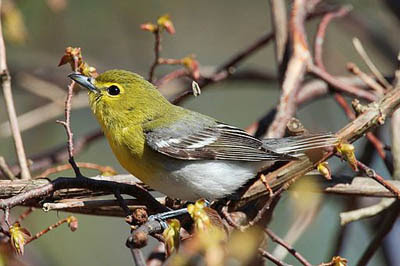 |
| Yellow-throated Vireo. MDF. CC BY-SA 3.0 |
These birds are blue-gray above, white below. Two white wing bars. Their head is olive yellow with yellow spectacles around the eye, and bright yellow throat.
These birds like large tracts of unbroken deciduous or mixed woodlands. Interestingly, however, they are often found on forest edges.
Yellow-throated Vireos are summer residents throughout Ohio.
Hooded Warbler
These birds are found low down in the forest understory. They flash white tail corners.
 |
| Male Hooded Warbler. Christopher O’Toole. Pixabay. |
Males are dark green above with a black cowl over the crown and onto the throat. Face and under parts are bright yellow. White tail corners.
Females are similar, but lack the black of the male. The crown is green and the throat yellow.
These birds are found in deciduous woods and swamps, primarily in brushy understory.
Hooded Warblers are summer residents throughout most of Ohio, absent in western and northwestern Ohio.
Yellow-breasted Chat
These unique larger yellow birds may sing day and night, and include whistles and crow-like cawing, often given in a display flight.
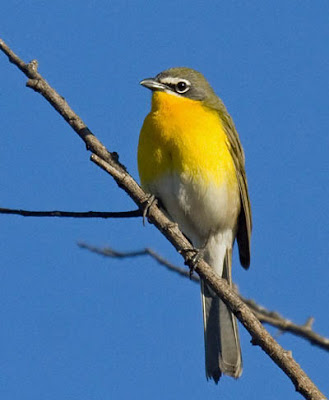 |
| Yellow-breasted Chat. Greg Gillson. |
These birds are greenish above with bright yellow breast and white belly. They have a dark mask bordered with white.
These birds live in tangles and wet woods.
Yellow-breasted Chats are summer residents throughout Ohio.
Wrapping Up
Ohio has many colorful birds, not just red, orange and yellow. Here are some of my favorite colorful birds and where you might find them:
Ohio boasts a kaleidoscope of feathered friends, many adorned with stunning plumage. Here are some of the most vibrant birds you might encounter in the Buckeye State:
Woodland Beauties:
- Scarlet Tanager: Males flaunt a fiery crimson body, black wings, and black wing bars. Look for them in open woodlands and deciduous forests during breeding season.
- Summer Tanager: Males sport a dazzling plumage with a crimson body, black head, and white wing bar. They favor deciduous forests and woodlands during their spring and summer stay.
- Indigo Bunting: Males showcase a deep blue body with black streaks and a white wing bar. Their high-pitched song adds melody to woodlands and shrubby areas.
- Cedar Waxwing: These bohemian beauties possess silky gray plumage, a bright yellow band across their tail, and a distinctive red wax-like tip on some wing feathers. They’re often seen in flocks, flitting through forests and orchards.
- Eastern Bluebird: Males display a stunning coat of bright blue body feathers, orange breast, and white belly. They prefer open woodlands and fields with nesting cavities.
Open Country Jewels:
- Western Meadowlark: The state bird of Michigan, the Meadowlark exhibits a bright yellow breast, black bib, and white V on its back. Their melodious song resonates across open fields and meadows.
- Bobolink: Males showcase a black and white body pattern with a buffy wing patch and a distinctive white rump. Listen for their bubbling song as they soar over meadows and grasslands.
- Common Yellowthroat: These energetic warblers sport a bright yellow throat, olive-green body, and white wing bars. They flit through low vegetation in fields, marshes, and meadows.
Frequently Asked Questions
What birds look like Northern Cardinals in Ohio?
Several birds in Ohio share some similarities with the iconic Northern Cardinal, but each has its own distinct features to help you tell them apart:
Body Color:
- Rose-breasted Grosbeak: Males have a rose-red breast, black head with white wing bars, and a brown back. They’re smaller than cardinals and lack the pointed crest.
- Summer Tanager: Males have a vibrant crimson body, black head, and white wing bar. They’re slightly smaller than cardinals and lack the black mask.
- Scarlet Tanager: Males have a fiery crimson body, black wings, and black wing bars. They’re similar in size to cardinals but lack the black mask and crest.
Bill and Head Shape:
- Indigo Bunting: Males have a deep blue body, black streaks, and a white wing bar. They’re much smaller than cardinals and have a thinner, conical bill.
- Eastern Bluebird: Males have a stunning blue body, orange breast, and white belly. They’re smaller than cardinals and have a shorter, thinner bill.
- Cedar Waxwing: These bohemian beauties have silky gray plumage, a bright yellow band across their tail, and a distinctive red wax-like tip on some wing feathers. They’re smaller than cardinals and have a wider, flatter bill.
Habitat and Behavior:
- Rose-breasted Grosbeak: Prefer open woodlands, edges of fields, and even backyards with feeders. Their song is a rich, melodic whistle.
- Summer Tanager and Scarlet Tanager: Favor deciduous forests and woodlands during their spring and summer stay. Their calls are high-pitched and buzzy.
- Indigo Bunting: Found in woodlands and shrubby areas. Their song is a high-pitched, musical warble.
- Eastern Bluebird: Thrive in open woodlands and fields with nesting cavities. Their song is a clear, sweet carol.
- Cedar Waxwing: Seen in flocks flitting through forests and orchards. Their call is a high-pitched, squeaky trill.
What bird is orange and black in Ohio?
There are several possibilities for an orange and black bird in Ohio, depending on the specific shades of orange and black, size, and habitat where you saw it:
Common possibilities:
- Baltimore Oriole: Males have a striking appearance with bright orange body, black head and back, and white wing bars. They prefer open woodlands, forest edges, and riverbanks, and are common summer residents in Ohio.
- American Redstart: Males have a coal-black body with vivid orange patches on the sides, wings, and tail. They frequent open woodlands and forest edges, especially during migration periods.
- Common Yellowthroat: Males have a bright yellow throat that sometimes extends onto the face, giving the impression of an orange head. They’re smaller than Baltimore Orioles and Redstarts, and favor low vegetation in fields, marshes, and meadows.
Do goldfinches stay in Ohio in winter?
Yes, American Goldfinches are year-round residents in Ohio! They can be seen throughout the state in all seasons, even during the cold winter months.
Here’s why:
- Adaptations: Goldfinches have developed several adaptations to cope with winter conditions. Their thick downy feathers provide excellent insulation, and their sharp beaks are perfect for extracting seeds from frozen plants and cones.
- Food Availability: Even though insects are less plentiful in winter, goldfinches can still find plenty of food sources. They primarily feed on thistle seeds, which remain available on plants like coneflowers and sunflowers throughout winter. Additionally, they can eat other seeds, berries, and buds.
- Flocking: During winter, goldfinches often form large flocks for warmth and to improve their chances of finding food. These flocks can be seen flitting between fields, hedgerows, and feeders, adding a splash of color to the winter landscape.
However, it’s important to note that some goldfinches may migrate south in search of more abundant food sources, especially during harsher winters. But even so, Ohio still maintains a significant population of these resilient birds throughout the year.
Related Articles:
See photos and learn about the most common backyard birds in Ohio, regardless of color.
See photos and learn what to feed winter birds in Ohio.
Here’s a quick tutorial of how I would teach you to identify birds: 7 Steps to Identify Birds!
Birds with red heads in North America.
Yellow-and-black birds in North America.


